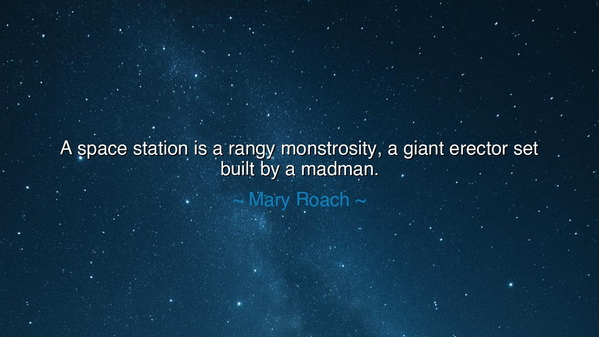
A space station is a rangy monstrosity, a giant erector set built






Hear, O listeners, the vivid words of Mary Roach: “A space station is a rangy monstrosity, a giant erector set built by a madman.” Though spoken with wit, these words contain a deeper vision of the human spirit and its creations. For what seems at first ungainly, chaotic, and strange is in truth the manifestation of our boundless daring—the will to take fragments of metal and machinery and stitch them together into a citadel suspended among the stars.
The meaning lies in the contrast between appearance and essence. The space station, with its tangled modules, jutting solar wings, and labyrinthine corridors, lacks the symmetry and elegance of a cathedral or temple. It is, to the eye, a clumsy beast, a monstrosity of bolts and panels. And yet, within this odd form, life thrives where life was never meant to be. Human beings eat, sleep, labor, and dream in the void, carried by an architecture that seems wild but functions with profound precision. To call it the work of a madman is to acknowledge both its strangeness and its genius, for madness and genius are often but two faces of the same flame.
The origin of such structures lies in humanity’s eternal desire to reach upward. Just as the builders of Babel once sought to pierce the heavens with stone, so too have modern engineers and dreamers sought to dwell among the stars with steel. But unlike Babel, which was struck down in confusion, the space station endures—an ungainly sanctuary where the nations of Earth unite in shared purpose. Its very awkwardness is the signature of collaboration, for each piece reflects the labor of different peoples, joined together in a single sky-borne dwelling.
History shows us that many of humanity’s greatest works were first dismissed as monstrous. When the Gothic cathedrals rose in medieval Europe, their flying buttresses and towering spires seemed grotesque to some, unbalanced and unnatural. Yet within their walls, light poured through stained glass, lifting souls to heaven. So it is with the space station: what seems strange from without is holy within, for it shelters the fragile breath of man in the wilderness of the cosmos.
Consider also the International Space Station itself, assembled piece by piece over decades. Astronauts compared its construction to building a ship while at sea—each module docked, bolted, and wired in orbit, each addition an act of faith and precision. No architect could have drawn a single elegant plan for such a venture; instead, it grew like a living organism, adapting, expanding, and surviving. Its appearance reflects this history: an ungainly patchwork, yes, but one that speaks of persistence, ingenuity, and the audacity to create order in chaos.
The lesson, O listener, is to look beyond beauty’s conventional form. Do not dismiss what appears strange, awkward, or monstrous, for within such creations may dwell the highest expression of the human will. True greatness often seems ungainly at birth: the awkward machinery of progress, the rough drafts of genius, the first fragile attempts to build where no one has built before. The madman who dares to dream may be the one who carries the world forward.
Therefore, in your own life, when you face the chaos of creation—when your efforts seem messy, your beginnings disordered—remember the space station. Embrace the clumsy first steps, the strange shapes that arise in your work. Trust that in time, the monstrosity will reveal its purpose, and the ungainly will become majestic. For it is not elegance that conquers the void, but persistence, imagination, and the courage to build even when the result looks mad.






AAdministratorAdministrator
Welcome, honored guests. Please leave a comment, we will respond soon